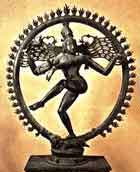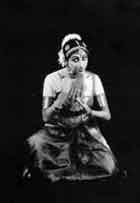Arangetram is a word in the Tamil language, which means the etram or ascending of the
arangu or performance stage by a dancer, on the completion of her
training.
Arangetram is the first public performance, which takes place in the
presence of critics, fellow artists, family and friends. Arangetram
takes place only after the student (artist) has acquired a substantial
and qualitative high standard repertoire.
Arangetram is an old tradition and is mentioned in the third century
classic Silappadikaram. In the third chapter, "Arangetrukaadai"
or the chapter of ascending the stage, the poet
Prince Ilango Adigal describes the
graduation concert of the twelve- year old dancer Madhavi.
After the arangetram (podium debut) the dancer can perform alone and
he/she can also give training to others. Its necessary that
before they can take upon the task of teaching, they should have a good understanding of music and other
aspects of dance. The learning process
does not end at arangetram. Students still go to their teacher to learn
more and this process of learning is basically never ending. It is
important for them to have a trained person correcting them and guiding
them, otherwise they will stagnate.
Indian music and dance |
   |

